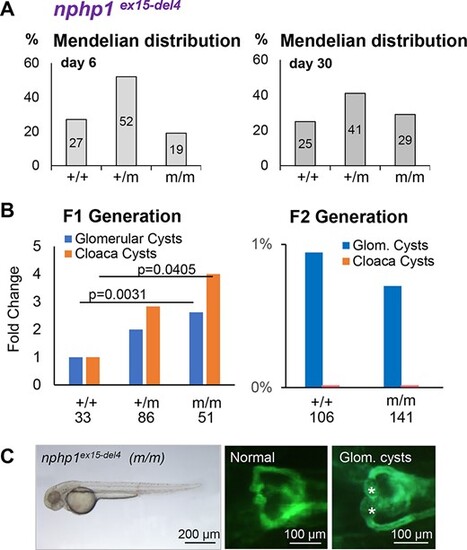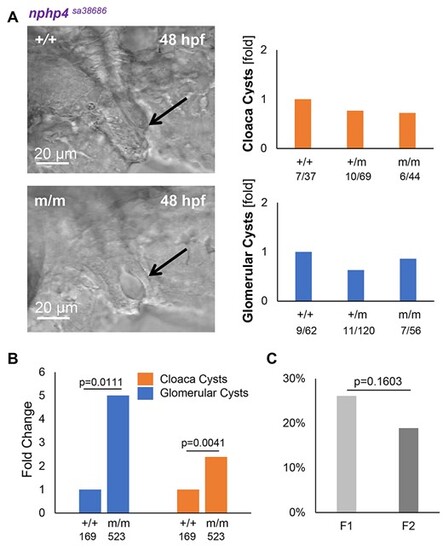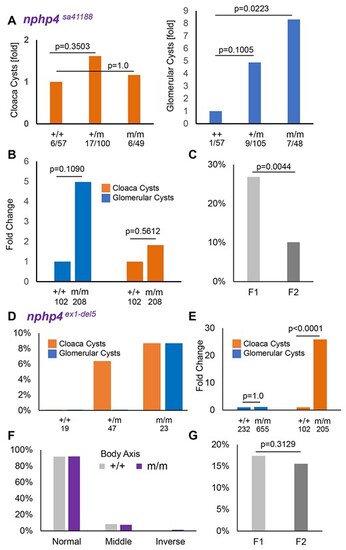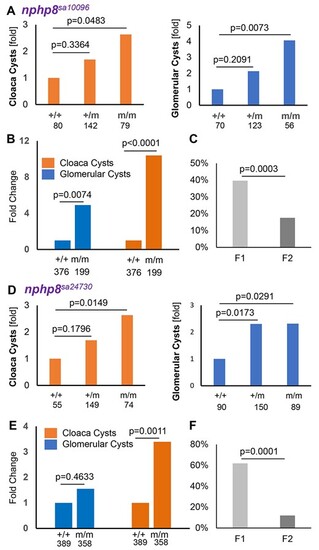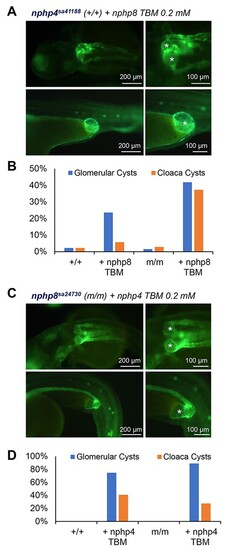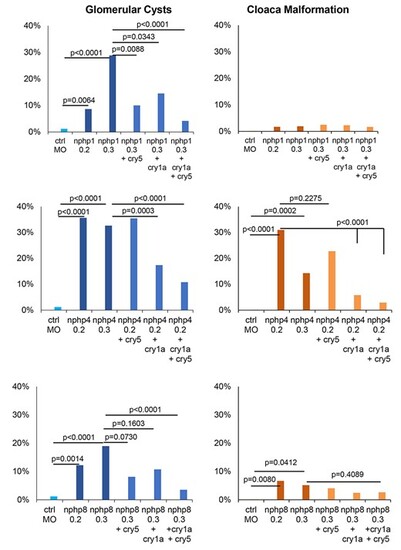- Title
-
Clock genes rescue nphp mutations in zebrafish
- Authors
- Kayser, N., Zaiser, F., Veenstra, A.C., Wang, H., Göcmen, B., Eckert, P., Franz, H., Köttgen, A., Walz, G., Yakulov, T.A.
- Source
- Full text @ Hum. Mol. Genet.
|
Characterization of nphp1-deficient zebrafish. (A) Exon 15 of zebrafish nphp1 was targeted by CRISPR/Cas9 to generate the nphp1ex15-del4 mutant zebrafish. Analysis at 6 and 30 days post fertilization revealed normal Mendelian distributions after incross of heterozygotic nphp1+/ex15-del 4 zebrafish, revealing that nphp1-deficient zebrafish is viable. The number of embryos per genotype is depicted inside the bars. (B) Heterozygote (+/m) and homozygote (m/m) mutants showed a progressive increase in glomerular and cloaca cyst formation in comparison with wild-type zebrafish (Fisher's exact test, two-tailed). However, the F2 generation of homozygote nphp1-deficient zebrafish [nphp1ex15-del4 (m/m)] did not develop more glomerular cysts or cloaca malformation in comparison with their wild-type siblings. The numbers displayed below the graph depict the group size. (C) While nphp1ex15-del4 (m/m) zebrafish embryos displayed a normal body axis, occasional glomerular cysts were detectable at 48 hpf. The asterisks (*) mark the glomerular cysts. |
|
Maternal zygotic nphp4sa38686 (m/m) zebrafish mutants display an increase in cyst formation. (A) Crossing of heterozygote +/nphp4sa38686 did not increase glomerular cysts or cloaca malformation. The left images depict typical examples of normal (+/+) and defective cloaca formation (m/m) in zebrafish embryos at 48 hpf, visualized by DIC microscopy. The arrows point to a normally developed cloaca (upper panel) and a cloaca cyst (bottom panel). The numbers below the graphs depict the fraction of embryos with cysts and the total number of analyzed embryos. (B) Crossing of homozygote nphp4sa38686 (m/m) zebrafish resulted in a 5-fold increase in glomerular and in a 2-fold increase in cloaca cyst formation in homozygote (m/m) maternal zygotic zebrafish embryos in comparison with wild-type (+/+) siblings (Fisher’s exact test, two-sided). The numbers displayed below the graph depict the group size. (C) The combined number of glomerular and cloaca cyst formation declined slightly from the nphp4sa38686 (m/m) F1 to the F2 generation (Fisher’s exact test, two-sided). |
|
Characterization of nphp4sa41188 and nphp4ex1-del5 mutant zebrafish lines. (A) While homozygote nphp4sa41188 (m/m) zebrafish did not experience an increased frequency of cloaca malformation, the number of glomerular cysts was significantly increased (Fisher’s exact test, two-sided). (B) The homozygotic (m/m) in-cross (F2 generation) showed a moderate increase in glomerular cyst and cloaca malformation that was statistically not significant. (C) The combined number of glomerular and cloaca cyst formation declined significantly from the nphp4sa41188 (m/m) F1 to the F2 generation (Fisher’s exact test, two-sided). (D) Crossing of heterozygote +/nphp4ex1-del5 zebrafish did not result in a significant increase in either glomerular cysts or cloaca malformation. (E) Generation of homozygote nphp4ex1-del5 (m/m) F2 zebrafish increased the number of cloaca malformation in comparison with wild-type siblings, but not the number of glomerular cysts. (F) Other ciliopathy phenotypes such as abnormalities of the body axis, were comparable between wild-type siblings and homozygote nphp4ex1-del5 (m/m) F2 zebrafish. (G) The combined number of glomerular and cloaca cyst formation declined slightly from the nphp4ex1-del5 (m/m) F1 to the F2 generation; however, the difference was statistically not significant (Fisher's exact test, two-sided). The numbers displayed below the graphs depict the group size. |
|
Characterization of nphp8sa10096 and nphp8sa24730 mutant zebrafish lines. (A) Homozygote nphp8sa10096 (m/m) zebrafish displayed an increased frequency of cloaca malformation and glomerular cysts. (B) The homozygotic (m/m) incross (F2 generation) showed an increase in glomerular cyst and cloaca malformation. (C) The combined number of glomerular and cloaca cyst formation declined significantly from the nphp8sa10096 (m/m) F1 to the F2 generation. (D) Heterozygote nphp8sa24730 (+/m) and homozygote nphp8sa24730 (m/m) zebrafish displayed an increased frequency of cloaca malformation and glomerular cysts. (E) While glomerular cyst formation was not more frequent between wild-type siblings and the mutant F2 generation (m/m), cloaca malformation increased significantly. (F) Comparison between the F1 and F2 generation, combining glomerular cyst and cloaca malformation, revealed a decline of combined glomerular cyst and cloaca malformation similar to the nphp8sa10096 mutation. The number of examined embryos is depicted below the graphs. All P values were calculated, using the two-sided Fisher’s exact test. |
|
Resilience of nphp4 mutant zebrafish lines against MO-mediated nphp4 depletion. Wild-type siblings (+/+) or homozygote nphp4 mutants (m/m) zebrafish embryos were treated with SBM or TBM (0.1 or 0.2 mm). Glomerular cyst and cloaca malformation were expressed as fold change in relationship to control MO-injected zebrafish embryos (0.2 mm). While wild-type siblings remained sensitive to either SBM or TBM and primarily developed glomerular cysts, mutant zebrafish displayed a blunted response, suggesting resistance to MO-mediated nphp4 depletion. The numbers displayed below the graph depict the respective group size. |
|
Susceptibility of nphp mutants in response to depletion of additional nphp genes. (A) Zebrafish nphp4sa41188 (+/+) siblings developed glomerular cysts and cloaca malformation (asterisks) after depletion of nphp8 with TBM (0.2 mm). (B) While the nphp4sa41188 in-cross (F2 generation) (m/m) was viable and displayed very little ciliopathy-specific phenotypes, additional depletion of nphp8 with TBM (0.2 mm) increased the frequency of glomerular cysts and cloaca malformation in comparison with nphp4sa41188 (+/+) siblings. (C) Zebrafish nphp8sa24730 (m/m) developed glomerular cysts and cloaca malformations (asterisks) after depletion of nphp4 with TBM (0.2 mm). (D) The nphp8sa24730 in-cross (F2 generation) (m/m) was viable and displayed very little ciliopathy-specific phenotypes. Additional depletion of nphp4 with TBM (0.2 mm) slightly increased the frequency of glomerular cysts, but had little effect on cloaca malformation. |
|
Circadian clock genes are part of the nphp8 genetic network controlling the ciliopathy-specific phenotypes. (A) Differential expression studies of nphp8sa24730 mutants and control siblings identified the circadian clock genes cry1a, cry5 and per2 as upregulated in the nphp8 mutants. (B) Depletion of cry1a and cry5 in Tg(wt1b:GFP; cdh17:GFP) embryos with two different MO each (SBM and TBM) significantly increased the frequency of glomerular cyst malformations compared to control morpholinos. Cloaca malformations were also significantly increased, but to a lesser extent. The numbers below the graphs depict each group size. (C) Depletion of cry1a with SBM in the nphp8sa24730 in-cross (F2 generation) more than doubled the frequency of glomerular cyst formation in comparison with control siblings; depletion with cry1a TBM led to a slight, but not significant increase in glomerular cysts (left graph). Depletion of cry5 with SBM or TBM in the nphp8sa24730 in-cross (F2 generation) almost doubled the frequency of glomerular cyst formation without reaching significance (defined by P < 0.05). Glomerular cysts were expressed as fold change in relationship to control MO-injected zebrafish embryos. The numbers above the graphs depict the group size. All P-values were calculated using Fisher’s exact test. |
|
MO-mediated knockdown of the components of the nphp1-4-8 module. TBMs were used to deplete zebrafish nphp1, nphp4 and nphp8 as indicated. Glomerular cysts and cloaca malformation (cloaca cysts) were expressed in comparison with control MO-injected zebrafish embryos. The control represents the average of six independent control MO injections at concentrations between 0.2 and 0.4 mm. The MO concentrations (mm) are shown below the group names. |

